Depression in Dogs: Causes, Signs and Treatments
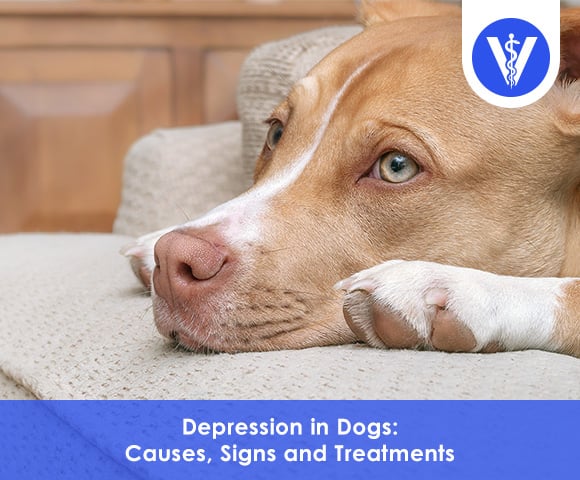
Table of Contents
Depression in dogs is a serious mental health condition manifesting in low mood and loss of interest in daily activities. Depression in dogs is a complex issue that negatively affects the dog’s life quality.
Many factors, including household changes, boredom, anxiety, social group changes, harsh training methods, seasonal affective disorder, death of a companion, and chronic pain, cause dog depression. The underlying cause of depression is hard to pinpoint in some situations.
Common signs of depression in dogs are pronounced withdrawal, loss of appetite, and changes in the sleep-wake cycle. Sad dogs exhibit behavioral problems and act out of the ordinary.
Veterinarians diagnose depression based on the dog’s history and clinical signs and after ruling out other medical conditions. There are no specific tests for dog depression, and healthy communication between the owner and the veterinarian is essential for a correct diagnosis.
Depressed dogs require a multimodal treatment strategy that entails environmental changes, behavior modification, supplements, and prescription medications or antidepressants.
What is Depression in Dogs?
Depression in dogs is defined as a mental health condition causing an ongoing low-mood state and disinterest in activities that once brought joy. Depression in dogs affects behavior, sleep patterns, and appetite.
Mayo Clinic defines depression as a ”persistent feeling of sadness.” Dog depression is complex and negatively impacts the dog’s quality of life.
Mondo E. and associated published a paper in Applied Sciences in 2020 titled “Depression and Microbiome—Study on the Relation and Contiguity between Dogs and Humans.” The authors compared the gut microbiota composition of 12 German Shepherds with depression to the microbiome of 15 mixed-breed dogs without depression. The gut microbiota of depressed German Shepherds differed from that of non-depressed mixed dogs. Certain microbial groups found in the German Shepherds are identified in humans with depression, suggesting the existence of a depression-specific “core” microbiota.
The depression-related changes in the dog’s gut microbiome indicate that depression as a mental state has deeper consequences, affecting the psychological and physical well-being of canines.
What are the Causes why Dogs Suffers Depression?
The causes of why dogs suffer depression are listed below.
- Household Changes: Dogs need to feel confident in their surroundings, and changes in the environment make them feel insecure. Major home re-organizations, construction work inside the house, or moving from one place to another are common causes of depression in dogs. Pet owners wondering, “Is my dog depressed?” must consider all changes in the household.
- Social Group Changes: Changes in the social dynamic affect dogs negatively. Having a different work schedule and coming home later than usual makes dogs depressed. Low mood is caused by many situations, such as the death of a human, canine, or feline companion, children leaving for college, or getting a new pet.
- Lack of an Outlet: Dogs are bred innately to complete tasks and roles such as hunting, herding, and protection. Modern dogs are pets but are still hard-wired to perform specific roles. Dogs without an outlet for innate behaviors experience frustration, which progresses to boredom and culminates in depression.
- Boredom: Depression is, in some dogs, a result of boredom. Animals published a study, “Could Greater Time Spent Displaying Waking Inactivity in the Home Environment Be a Marker for a Depression-Like State in the Domestic Dog?” in 2019. The study included 57 dogs from seven shelters and concluded that spending time awake but motionless (ABM) is a sign of boredom rather than depression.
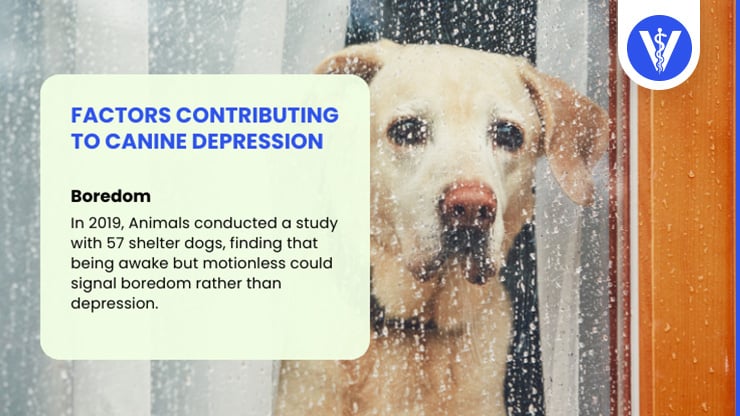
- Fears and Phobias: Depression in dogs is a symptom of stress. Separation anxiety and noise phobias make dogs withdrawn and visually depressed. Fears and phobias affect different dogs uniquely.
- Inappropriate Training Methods: Heavy-handed training techniques relying on yelling, harsh conditioning, and punishment destroy the dog’s confidence, resulting in learned helplessness. The state appears like obedience but is a sign of chronic stress and depression.
- Seasonal Affective Disorder (SAD): Seasonal affective disorder occurs in winter when dogs are unable to exercise regularly. Physical activity and mental stimulation are in canine genes and cause depression when unfulfilled.
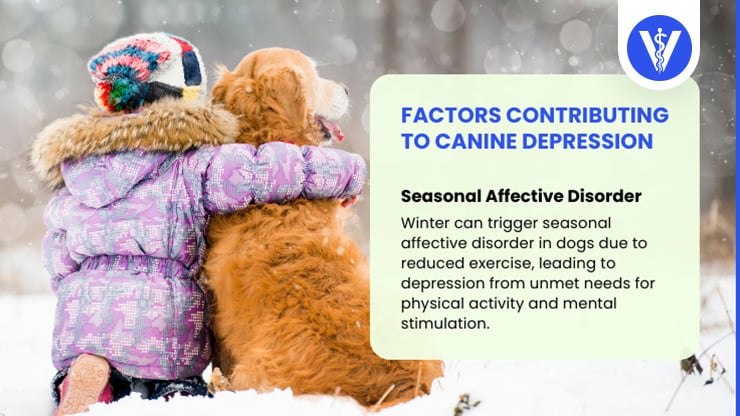
- Chronic Pain: Pain causes depression in dogs. Conditions resulting in chronic pain in dogs include osteoarthritis, intervertebral disc disease, pancreatitis, periodontal or gum disease, ear infections, and traumatic injuries.
- Owner Mirroring: Dogs are empathetic creatures that copy pet owners’ feelings. The finding was confirmed in a 2019 study published in Scientific Report, “Long-term stress levels are synchronized in dogs and their owners.” Depression in dogs occurs when the owners are depressed.
How is Depression Different from Anxiety in Dogs?
Depression is different from anxiety in dogs in terms of duration and continuity. Depression in dogs is an ongoing low-mood state of a shorter duration. Dog anxiety occurs in discreet episodes but lasts longer.
Depression is less psychologically complex than dog anxiety. Depression and anxiety harm the dog’s physical and mental health and lower the overall quality of life.
Dog depression is often mistaken for other health conditions, especially in seniors. Chronic pain associated with arthritis or canine cognitive dysfunction (CCD) mimics the signs of depression and masks its presence.
What are the Signs that your Dog is Experiencing Depression?
The signs that your dog is experiencing depression are listed below.
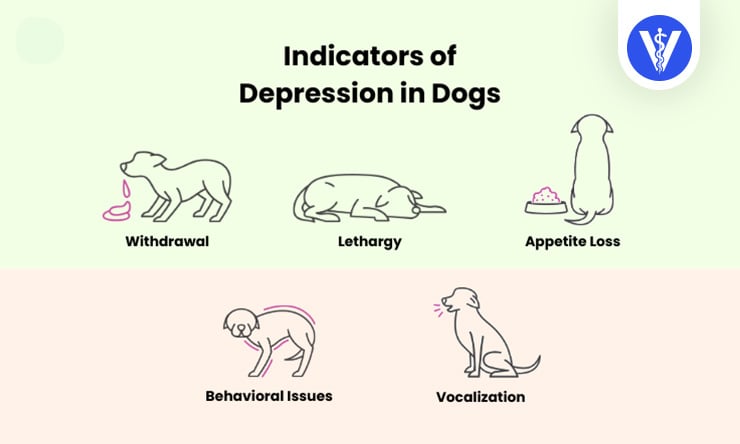
- Withdrawal: The dog seems distant and has little to no enthusiasm for participating in activities it usually enjoys, like going to the dog park, playing tug-of-war, or cuddling on the couch. Withdrawal is the first sign of depression in dogs.
- Lethargy: Lethargy manifests with low energy levels and an increased tendency to sleep or stay awake but motionless. Lethargy is a prevalent sign of depression in dogs. Lethary is one of the signs of depression in dogs, but it is not specific, and lethargy occurs with many health issues.
- Appetite Loss: Reluctance to eat is a widespread symptom among depressed dogs. The dog has a reduced appetite or complete loss of interest in food or anorexia.
- Behavioral Issues: Increase in destructive activities such as chewing, digging, scratching, high irritability, intense clinginess, loss of toilet training (peeing and pooping inside the house), and escaping attempts are all potential signs of depression in dogs.
- Vocalization: Depressed dogs are either quieter or more vocal than usual, showing changes in their tendencies to bark, whine, howl, and whimper. The vocalization change is sudden and appears unprovoked.
What can you do for your Dog Suffering from Depression?
You can provide a little extra love and care for your dog suffering from depression. The best support for depression in dogs is to show how much it is loved. Pet owners wondering how to cheer them up must ensure the dog gets more of what makes it happy.
Provide ample physical and mental stimulation to appropriately engage the dog’s body and mind. Ensure the dog gets social and quality time alone, playing with an interactive toy.
Dogs that are depressed because of losing a companion cheer up during social events. Set up play dates or visit the local dog park frequently to help the dog overcome grief.
Dogs reluctant to eat due to depression benefit from food enhancers and tasty toppers. Make the food more enticing to stimulate appetite and ensure healthy nutrition during critical times.
Look for small changes in the dog’s mood and reward happiness by praising or giving treats. Do not encourage negative moods or give rewards and attention while moping because rewards reinforce the negative behavior.
There is no universal approach to managing depression in dogs, and the ideal course of action depends on the underlying cause.
How can Veterinarians Diagnose Dogs’ Depression?
Veterinarians can diagnose dogs’ depression based on clinical signs after ruling out other medical conditions. A specific test for diagnosing depression in dogs does not exist.
The veterinarian takes a history of the dog to learn how the dog behaves and looks for significant events in the dog’s life. The veterinarian performs a thorough physical exam to evaluate the dog’s health.
Based on the initial findings, the veterinarian recommends diagnostic procedures such as blood work, urinalysis, x-rays, and ultrasounds.
The absence of physical conditions and disease making the dog sad indicates dog depression as a potential diagnosis. The veterinarian refers the dog to a veterinary behaviorist to confirm the diagnosis.
Can Depression in Dogs be Treated?
Yes, depression in dogs can be treated. John Ciribassi, DVM and former president of the American Veterinary Society of Animal Behavior (AVSAB), explains, “Most dogs bounce back from depression within a few days to a few months with just a little extra TLC.”
Ciribassi recommends, “Keep them engaged, do more of the things they like to do, get them a little more exercise, and they should be fine.”
What are the Treatments for Depression in Dogs?
The treatments for depression in dogs are listed below.
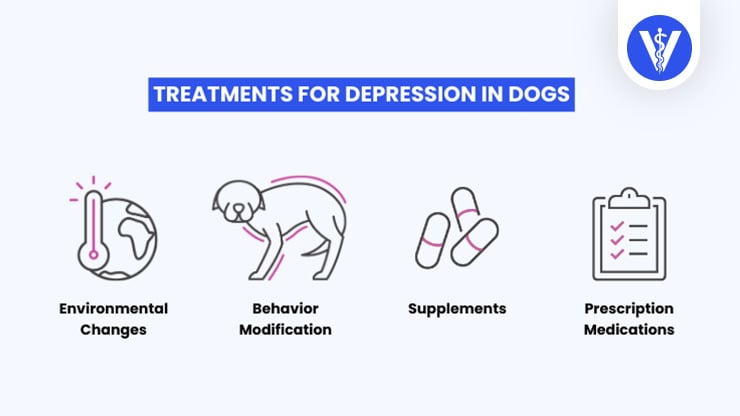
- Environmental Changes: The first and easiest step in treating depression in dogs is making environmental changes. The approach is helpful for dogs triggered by changes in immediate surroundings. Providing a safe spot and environmental enrichment, such as puzzles and dog games, are integral to the treatment. Environmental changes alone are not enough to eliminate depression but are essential to a multimodal approach to treatment.
- Behavior Modification: Take behavior modification into consideration, depending on the underlying cause of the dog’s depression. Behavior modification is an umbrella term covering various techniques. Successful behavior modification often involves consulting a primary care veterinarian who practices veterinary behavior or, in more severe cases, hiring a licensed veterinary behaviorist or a certified applied animal behaviorist.
- Supplements: The three main supplements for depression in dogs are fish oil, probiotics, and CBD oil. Fish oil is rich in essential omega-3 and omega-6 fatty acids, which support healthy brain function. The anti-inflammatory properties of omega fatty acids have a mood-enhancing effect. Probiotics are linked with mood improvement and are a readily available supplement for dogs. The gut houses billions of bacteria, some of which are nourishing to serotonin and other happy-supporting hormones. CBD oil promotes neurological health, helps ease anxiety, and balances brain chemicals, resulting in a happy, relaxed mood. CBD supplements come in many forms, from oils to capsules to treats, and relieve the symptoms of depression in dogs.
- Prescription Medications: Dogs with severe forms of depression require medications. Commonly used antidepressants for depression in dogs are tricyclics (TCAs), selective serotonin reuptake inhibitors (SSRIs), monoamine oxidase inhibitors (MAOIs), and novel antidepressants. Karen Sueda, DVM and a diplomat of the American College of Veterinary Behaviorists, says that “medications for depressed dogs are the same as those used by depressed humans.” The use of antidepressants in dogs must be approved and instructed by a licensed veterinarian. Antidepressants “are all toxic to your dog if too much is ingested,” and antidepressant medication is the cause of “one of the top 10 poisonings in dogs,” according to the official WagWalking website.
Can CBD Oil Treat Dogs’ Depression?
Yes, CBD oil treats dog depression. CBD, or cannabidiol, is a natural compound found in the hemp version of the Cannabis sativa plant.
A survey including more than 2000 people showed that 1 in 6 people use CBD for depression management, and two-thirds stated CBD worked well. The earliest written record of hemp being used as a cure for depression is in the English clergyman Robert Burton in his book “The Anatomy of Melancholy” from 1621.
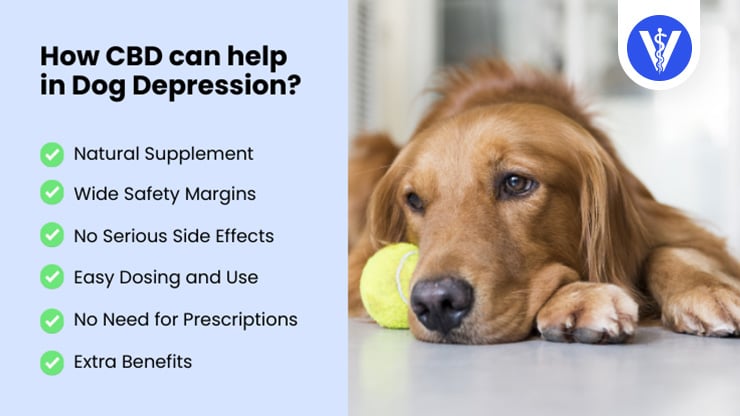
CBD for dogs works naturally through the ECS or endocannabinoid system. The endocannabinoid system (ECS) is the same and works the same in humans and dogs. The anti-depressant effects of CBD in humans are expected in depression in dogs. CBD oils, treats, and other supplements are an excellent addition to the multimodal depression treatment plan.
What are the Properties of CBD Oil that Help with Dog Depression?
The properties of CBD oil that help with dog depression are listed below.
- Serotonin Effect: Cannabinoids activate the 5-HT1A serotonin receptors and mimic its effects. Serotonin (5-hydroxytryptamine) is a chemical in the brain, known as a neurotransmitter, responsible for mediating satisfaction and happiness.
- Neurological Support: CBD for dogs aids the treatment of neurological disorders through its potent anti-inflammatory, neuroprotective, and antioxidant properties. CBD helps balance the chemicals in the brain and boosts cognitive function in depression in dogs.
- Pain Control: Pain and depression co-exist in many dogs, and reducing the pain results in improved mood. CBD helps relieve pain experienced in depression in dogs, from mimicking the effects of serotonin to inhibiting anandamide deactivation to interacting with TRPV1 receptors.
- Anxiety Relief: Anxiety is a major component of depression in some cases, and supporting relaxation helps enhance the dog’s mood. CBD has proven anxiolytic and panicolytic effects and promotes natural calmness and relaxation.
- Gut Health: Many studies have proven the gut-brain axis, and a healthy gut is associated with a good mood. CBD boosts overall digestive wellness, and in low doses, cannabinoids act as probiotics, are good for gut bacteria, and help with depression in dogs.
What are the Benefits of CBD Oil for Dogs?
The benefits of CBD oil for dogs are listed below.
- Natural Supplement: Dog CBD oil is an all-natural product sourced from hemp plants. Natural supplements are safer long-term and have fewer adverse effects than mainstream medications. High-quality CBD products are made with organic ingredients and are free from potentially harmful artificial additives and preservatives.
- Wide Safety Margins: CBD for dogs, as a natural supplement, has wide safety margins. Cannabinoids are fit to use in dogs of all ages, including puppies over four months old, adult dogs, and seniors. Dogs do not overdose on CBD, and cannabinoids are safe, non-addictive, non-psychogenic and helpful for depression in dogs.
- No Serious Side Effects: CBD for dogs does not cause long-term, serious side effects. Cannabinoids trigger temporary and benign reactions in some dogs, but only if the CBD oil is given abruptly and in very high doses.
- Easy Dosing and Use: Dog CBD products come in different forms, from oils to treats to capsules, with many potencies and pet-friendly flavors. The variety of CBD forms, strengths, and flavors makes CBD oil use for depression in dogs straightforward.
- No Need for Prescriptions: Hemp-sourced pet CBD products do not need a veterinarian prescription. CBD oil is available over the counter (OTC) and easy to purchase online or in pet stores.
- Extra Benefits: The benefits of CBD are not limited to depression in dogs. CBD promotes overall wellness, boosts cognition, supports immunity, and treats many conditions, such as allergies, arthritis, anxiety, hyperactivity, cancer, glaucoma, and seizures.
What are the Side Effects of CBD Oil for Dogs?
The side effects of CBD oil for dogs are listed below.
- Lethargy: Lethargy is one of the most common CBD adverse events and manifests with reduced energy levels, increased sleepiness, and disinterest in daily activities.
- Dizziness: Dizziness results in loss of balance and lack of coordination (ataxia) and is triggered by low-quality CBD products with more than 0.3% THC (tetrahydrocannabinol).
- Dry Mouth: Cannabinoids interfere with normal saliva production, causing dry mouth or xerostomia, which is not dangerous but is uncomfortable for depression in dogs.
- Vomiting: Vomiting is a frequent CBD side effect and is seen in dogs with sensitive stomachs whenever they start to use new supplements.
- Diarrhea: Diarrhea in dogs manifests with loose and frequent stool and is the result of the carrier oil used to dilute the cannabinoids in pet CBD products.
- Upset Stomach: Vomiting and diarrhea are symptoms of stomach upset and are common side effects of new supplements.
- Liver Enzyme Changes: CBD blocks the production of the liver’s cytochrome P450 enzyme, which alters the metabolism of certain drugs used to treat depression in dogs.
- Increased Tremors: Increased intensity and frequency of tremors are seen in people, but it is an infrequent adverse effect of CBD products for dogs
- Increased Itchiness: Pronounced itchiness, such as scratching, biting, and licking, is a rare but possible adverse effect of CBD for pets and develops in sensitive dogs.
- Low Blood Pressure: Cannabinoids lower blood pressure, causing hypotension, one of the common side effects of CBD, especially when used in high doses.
How to Use CBD Oil for Dog Depression Treatment?
To use CBD oil for dog depression treatment, follow the steps below.
- Consult the veterinarian regarding CBD. Talk to a veterinarian to plan a treatment and see how cannabinoids fit the strategy. CBD oil is counter-indicated for dogs receiving certain antidepressants because the two are not compatible. Cannabinoids increase the concentration of antidepressant medications, which is why the veterinarian needs to approve the use of CBD for depression in dogs using prescription drugs.
- Buy a High-Quality CBD Oil. The market is saturated with pet CBD brands, and not all products are of equal quality. Research different manufacturers and purchase from reputable and trustworthy brands. Reliable pet CBD brands are transparent about ingredients and feature the Certificate of Analysis (COA) for CBD products on the official website.
- Get the Correct CBD Strength and Flavor. CBD oils for treating depression in dogs are available in many strengths and flavors. Picking the correct strength for the dog’s size and body weight simplifies dosing. Getting the right flavor is important for easy CBD administration. Popular dog-friendly CBD flavors include chicken, beef, and peanut butter.
- Start with a Low CBD Oil Dose. Always start with the lowest CBD dose recommended for the dog’s weight. Read the manufacturer’s guidelines and start with a small CBD dose to give the dog’s body time to adjust and reduce the risk of unwanted side effects.
- Find the Best CBD Administration Method. CBD oil works fastest when given directly into the dog’s mouth, preferably under the tongue (sublingually). Options for depression in dogs include mixing CBD oil with pet food or pouring the liquid on a porous dog treat. Serving the oil with food slows absorption but is easier, especially in picky dogs.
- Try a Pet CBD Oil Alternative. Dogs reluctant to eat CBD oil require an alternative. Pet CBD brands offer additional products, like CBD-infused treats and soft chews or CBD-enriched edibles such as peanut butter making CBD dosing for depression in dogs easier.
- Stay Consistent with the CBD Use. Give the oil regularly, and do not expect overnight miracles. The cannabinoids start working once absorbed, but it takes time before there are visible improvements in the dog’s condition. Wait for four to six weeks to see a change, depending on the depression’s underlying cause and treatment plan.
How Much CBD Oil can I give to my Dog?
You can give your dog between 1 and 5 mg of CBD oil per 10 pounds of body weight. Cannabinoids are used once or twice per day, depending on the severity of the condition.
Start with a low CBD dosage of 2 mg per 10 pounds, or 0.2 mg per pound, and gradually increase the amount. Slow CBD introduction gives the dog time to adjust to the supplement and reduces the risk of side effects.
CBD dosing is not an exact science, and different depression in dogs results in different responses to CBD. Finding the correct amount takes trial and error. Use a CBD dosage calculator or consult the veterinarian to establish the best CBD oil dose.
What are Preventive Measures to Avoid Dog Depression?
The preventative measures to avoid dog depression are listed below.
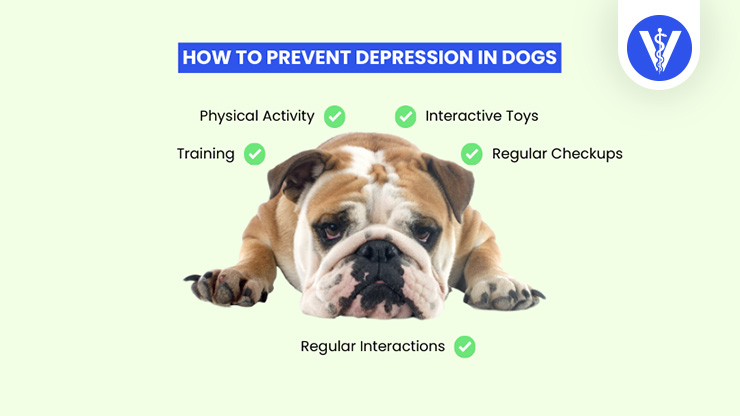
- Physical activity nourishes and stimulates dogs’ bodies and minds. Practice regular daily walks and allow dogs to sniff and explore while walking. Depression in dogs is minimized when dogs are engaged in everyday activities.
- Training helps the dog build confidence, reducing the risk of low moods and depression in dogs. Practice continuous obedience training or keep teaching the dog new tricks and commands as a form of brain stimulation.
- Regular interactions with other dogs, pets, and people keep the dog entertained and help prevent depression in dogs. Schedule play dates with your friends’ dogs or visit the park regularly.
- New toys are vital for environmental enrichment and keep the dog’s mind engaged in positive activities. Invest in high-quality, interactive toys such as stuffable Kongs, puzzles, puzzle feeders, and dog sudokus. Rotating the toys is an excellent way to ensure the dog does not lose interest in the toys.
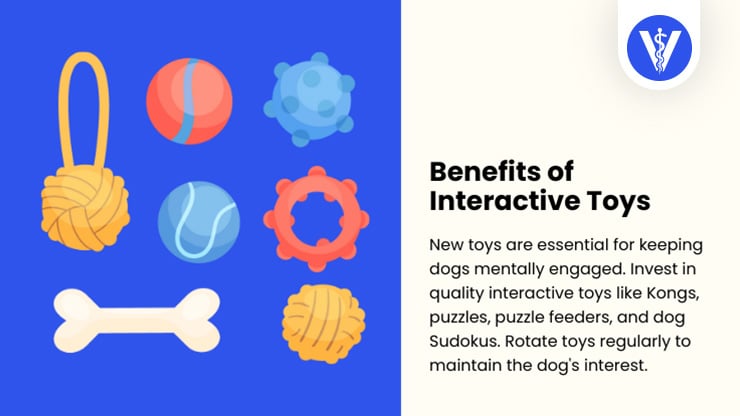
- Do not underestimate the importance of regular checkups at a licensed veterinarian. Orderly exams allow the veterinarian to assess the dog’s well-being and catch any issues before becoming serious.
Does Exposure to Other Dogs Allow Them to Overcome Dog Depression?
Yes, exposure to other dogs allows depressed dogs to overcome dog depression. Exposure to other dogs is highly beneficial if the depression is caused by the loss of a companion.
Researchers from New Zealand and Australia studied the “Owners’ Perceptions of Their Animal’s Behavioural Response to the Loss of an Animal Companion” in 2016. The results showed that depression in dogs following the loss of a companion lasted less than six months.
Exposure to other dogs or getting a new dog exacerbates depression in dogs if the depression has other underlying causes and the depressed dog refuses social interactions with other canines.
Is CBD Oil Safe for Dogs?
Yes, CBD oil is safe for dogs. Hemp-sourced and THC-free CBD oil and products are perfectly safe when used with the veterinarian’s approval and in sync with the manufacturer’s recommendations. CBD is suitable for all depression in dogs and puppies over four months of age.
CBD is a novel therapeutic, and many pet owners wonder, “Is CBD safe for animals?” The answer is yes. Frontiers in Veterinary Science, in the 2022 study titled “Long-term daily feeding of cannabidiol is well-tolerated by healthy dogs,” says that CBD is “well tolerated in clinically healthy dogs for a duration of 6 months.”
Similar results are found in “Scientific Validation of Cannabidiol for Management of Dog and Cat Diseases,” published in 2023 in Annual Reviews of Animal Biosciences. The study showed that “CBD appears to have good bioavailability and safety profile with few side effects.”
Can Dogs Get Depressed?
Yes, dogs can get depressed. Guide Dogs, a UK charity group, polled pet owners and found that as much as 74% of them reported some form of mental health issues in their dogs, with depression and anxiety being the most common.
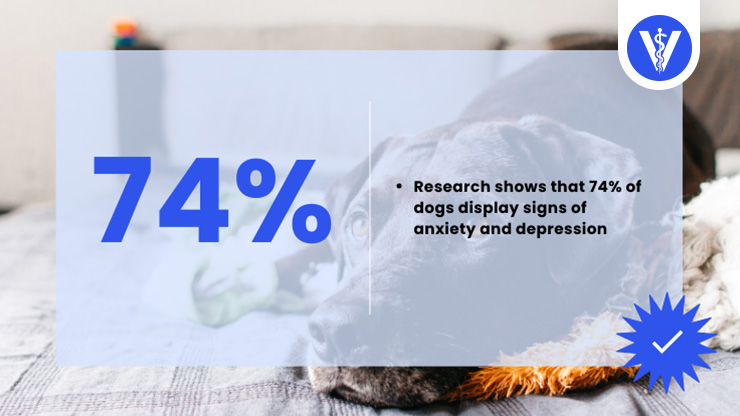
Depression in dogs is not the same as clinical depression in humans. Dogs experience depression in the form of sadness, blues, and grief.
















